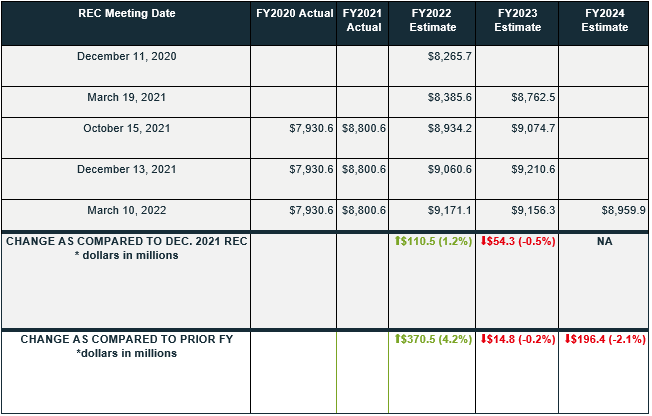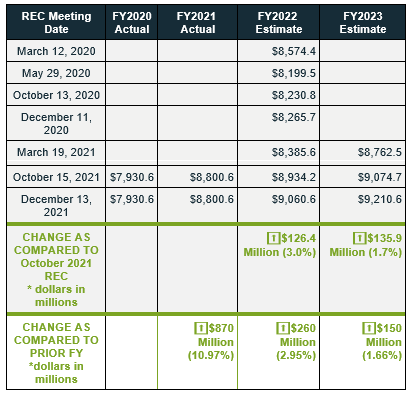03-11-2022 |
Government Relations Update - 03-10-2022
By: BrownWinick
March 10, 2022 / REC SUMMARY
The Revenue Estimating Conference (“REC”), comprised of a three-member panel (Kraig Paulsen, Holly Lyons, and David Underwood) met this morning (3/10/22) as part of their standard schedule of meetings to estimate future state revenues. A summary of the information discussed during the meeting is below, along with this linked spreadsheet distributed after the meeting, which contains more detailed revenue information by category (e.g. sales / use tax, personal income tax, etc.). A recording of the full meeting may be viewed here (LINK).
Important to Note: Today's REC number for FY22 is higher than the December estimate by $110.5 million. Recall, Governor Reynolds uses the December estimate to prepare her budget and the Legislature is required to use the lower of the December or March estimate for its fiscal year (“FY”) 2023 budgeting. Consequently, as a result of today’s meeting, the Legislature will be required to use the December estimate for its upcoming budget.
Summary: Iowa’s revenues continued to grow year over year. Specifically, FY22 revenue estimates grew by $370.5 million over FY21 actual revenues, which equates to nearly 4.2% growth. Importantly, this estimate also accounts for the future impact of a historic tax reform bill signed into law last week, which will reduce state revenues in future years due to lower tax rates - estimated to result in $14.8 million fewer dollars in FY23 as compared to FY22 estimates (equating to a 0.2% decrease in revenue for FY23). For additional background and perspective, the December 2021 REC summary is included below.

General Comments Regarding Factors Impacting Estimates:
- While there was a downshift in economic growth during the fourth quarter of 2021, the economy grew at a robust 5.7% (largest annual increase since early 80s);
- Farm commodity prices continue to increase;
- General fund revenue growth is up 7.8%
- Employment numbers are still below pre-pandemic peaks, but making monthly gains;
- The headwinds referenced in the December REC still exist, but seem more turbulent now, including:
- Inflation is higher than the 1980s and is showing signs of persistence;
- It has been a while since we have had to project revenue during inflation and we do not yet know how the federal reserve will respond;
- Supply chain issues still exist;
- Commodity prices are high;
- The war in Ukraine shows no signs of ending soon and there is economic cost associated with the uncertainty; while sanctions on Russia won’t impact Iowa trade, they will have an impact on fuel and food prices.
- LSA estimates reflect optimistic growth of 4.4% for FY22;
- Iowa’s economy continues to rebound from COVID;
- Iowa’s economy continues to expand amidst inflationary pressures;
- Demand continues to surge, despite rising prices;
- Labor market is tight and companies continue to hire;
- They do not believe that a possible federal reserve interest rate hike will derail growth;
- The risk of a downturn in the economy appears minimal
- The greatest uncertainty is related to Russia’s decision to invade Ukraine. While Iowa trade will not be as heavily impacted (Russia is Iowa’s 31st largest export partner and 56th largest import partner), it will cause continued and significant pressure on the supply chain;
- There could be upward pressure on ethanol prices if corn commodities continue to increase due to the war in Ukraine;
- Inventory build is shifting the demand curve out farther as inventory management models are moving from just-in-time to just-in-case;
- While the GDP contracted slightly in 3rd quarter, it is still up 3.4% over the pre-pandemic peak in 2019;
- Iowa has about 1.68 jobs open per unemployed person;
- Commodity prices are up sharply and land values are up significantly;
- Sales tax revenue has seen some moderation from very strong numbers early in the year, but continue to be healthy at 11.6%;
- Wages are up 6.8%;
- FY23 will start seeing impact of tax reform passed earlier in session (HF2317): revenue decrease of $236 million in FY23 and $561 in FY24
FY22 Revenue Estimate Revised UP from December 2021 Estimate:
- As a reminder, FY22 ends June 30, 2022. The REC increased its FY22 estimate from the December REC meeting by $110.5 million. This increase equates to projected Net Receipts Plus Transfers of $9,171.1 million, which reflects a 4.2% increase in revenues as compared to FY21.
FY23 Revenue Estimate Revised DOWN From December 2021 Estimate:
- As a reminder, FY23 begins on July 1, 2022 and ends June 30, 2023. The REC revised down its December FY23 estimate, as measured against the FY22 estimated revenues by $54.3 million (this reduction takes into account the tax cuts that were adopted during the 2022 session and within HF2317). Consequently, today's revised estimate means total estimated revenues for FY23 are $9,156.3, an overall decrease of $14.8 million from the FY22 numbers, or -0.2% growth.
FY24 Revenue Estimate Established:
- The REC also estimated revenues for FY24. Recall, FY24 begins on July 1, 2023 and ends on June 30, 2024 - 843 days from today. Given the impact of this year’s historic tax bill, the REC estimated revenues for the state would decrease $196.4 million in FY24 as compared to FY23 estimates, equating to $8,959.9 million, or -2.1% growth.
[ END OF MARCH, 10 2022 REC SUMMARY ]
December 13, 2021/ REC SUMMARY
The Revenue Estimating Conference (REC), comprised of a three-member panel (Kraig Paulsen, Department of Management; Holly Lyons, Legislative Fiscal Agency; and David Underwood, Public Member) met yesterday (12/13/21) to estimate future state revenues. The REC approved the Legislative Service Agency’s (LSA) FY22 estimates as presented in the attached spreadsheet (no change). However, the REC made the following changes to LSA’s FY23 estimates: 1) reduced Personal Income Tax by $54 million; 2) reduced Corporate Income Tax by $40 million; and 3) increased Sales/Use Tax by $14 million. The adjustments moved the Net Receipts Plus Transfers number from $9,290.6 to $9,210.6 ($80 million net decrease). Thus, growth for FY23 changed from 2.5% to 1.7%.
Important to Note: The REC’s number is purely an estimate. Governor Reynolds uses the December 2021 estimate to prepare her budget. The Legislature is required to use the lower of the December 2021 or March 2022 estimates for its upcoming fiscal year (FY) 2023 budgeting.
Summary: The REC’s report shows that revenues for the current fiscal year (FY22) are estimated to be $9,060.6 million, higher by 126.4 million than estimated during the October 15, 2021 REC meeting. This means there are estimated to be $260 million “new dollars” for FY22 as compared to FY21. Revenues projected for the upcoming fiscal year (FY23), which starts July 1, 2022, are estimated at $9,210.6 million, higher than the October estimate by $135.9 million. This means there are an estimated $150 million “new dollars” for FY23 as compared to FY22, or 1.7% growth for next year. For additional background and perspective, we have included the October 15, 2021; March 19, 2021; and December 11, 2020 REC summaries below.

General Comments from the REC Regarding Factors Impacting Estimates:
- The State of Iowa, the nation, and beyond are experiencing an economy in transition. Some of these changes have been caused by, or accelerated, by the COVID-19 pandemic. The pandemic has also created a change in consumer purchasing expectations. These expectations are being driven by labor shortage, supply chain challenges, and rising inflation.
- Job numbers for both the country and Iowa are still well below pre-pandemic levels. It will likely take the U.S. about 7 months to reach former employment peak. However, it will likely take Iowa over two years.
- Iowa continues to have more jobs than workers which is compounded by the pandemic with some people choosing not to return to the workforce for a variety of reasons.
- Iowa’s unemployment is at 3.9% with a 66.8% labor participation rate that continues to lag previous highs.
- Approximately 64,000 Iowans are looking for work with 110,000 available job openings.
- While employment is still down compared to 2020, wage and salary totals for Iowa do not seem to be impacted to the same degree. Salaries are on the rise.
- Supply Chain issues are in the news nonstop.
- Almost 100 ships are sitting off the coast of California waiting to be unloaded.
- The nation is experiencing a truck driver shortage, low retail inventories, and low manufacturers facilities’ inventory.
- The Bureau of Labor Statistics identified the current inflation surge of 6.8% as the largest 12-month jump since the beginning of 1982. This inflation, which was once thought to be transitory, and maybe even necessary, to fuel the struggling economy has been partly caused by the supply chain bottle neck and the inability of businesses to meet consumer demand.
- The cause and effect of the inflation numbers or how long it last can be debated, but the truth is it is uncertain. Product prices and state revenue traditionally move together.
- Iowa’s agriculture economy continues to benefit from high prices and good corn/soybean volumes.
- Real GDP growth continues at an annualized rate of 7.7%.
- Another headwind facing the Iowa economy is the unknown impact of the Omicron and future unknown variants of COVID-19.
- The number of deaths and significant illnesses must come down for the economic picture to stabilize.
FY22 Revenue Estimate Revised UP from October 2021 Estimate:
- As a reminder, FY22 ends June 30, 2022. The REC increased its estimate from October 2021 by 126.4 million. This increase equates to projected Net Receipts Plus Transfers of $9,060.6 million, which reflect a 3.0% increase in revenues (or $260 million new) as compared to FY21.
FY23 Revenue Estimate Revised UP from October 2021 Estimate:
- As a reminder, FY22 begins on July 1, 2022 and ends June 30, 2023. The REC revised up its FY23 estimate, as measured against the FY22 estimated revenues, by $135.9 million. Consequently, the REC’s revised estimate means total estimated revenues are $9,210.6 million for FY23, an overall increase of $150 million from the FY22 numbers.
[ END OF DECEMBER 13, 2021 REC SUMMARY ]